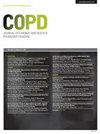Common Pathogeneses Underlying Asthma and Chronic Obstructive Pulmonary Disease -Insights from Genetic Studies
IF 3.1
3区 医学
Q1 Medicine
International Journal of Chronic Obstructive Pulmonary Disease
Pub Date : 2024-03-04
DOI:10.2147/copd.s441992
引用次数: 0
Abstract
Abstract: Neither asthma nor chronic obstructive pulmonary disease (COPD) is a single disease consisting of a uniform pathogenesis; rather, they are both syndromes that result from a variety of basic distinct pathogeneses. Many of the basic pathogeneses overlap between the two diseases, and multiple basic pathogeneses are simultaneously involved at varying proportions in individual patients. The specific combination of different basic pathogeneses in each patient determines the phenotype of the patient, and it varies widely from patient to patient. For example, type 2 airway inflammation and neutrophilic airway inflammation may coexist in the same patient, and quite a few patients have clinical characteristics of both asthma and COPD. Even in the same patient, the contribution of each pathogenesis is expected to differ at different life stages (eg, childhood, adolescence, middle age, and older), during different seasons (eg, high seasons for hay fever and rhinovirus infection), and depending on the nature of treatments. This review describes several basic pathogeneses commonly involved in both asthma and COPD, including chronic non-type 2 inflammation, type 2 inflammation, viral infections, and lung development. Understanding of the basic molecular pathogeneses in individual patients, rather than the use of clinical diagnosis, such as asthma, COPD, or even asthma COPD overlap, will enable us to better deal with the diversity seen in disease states, and lead to optimal treatment practices tailored for each patient with less disease burden, such as drug-induced side effects, and improved prognosis. Furthermore, we can expect to focus on these molecular pathways as new drug discovery targets.Keywords: Asthma, chronic obstructive pulmonary disease (COPD), endotype, precision medicine, treatable traits approach
哮喘和慢性阻塞性肺病的共同病原体--遗传研究的启示
摘要:哮喘和慢性阻塞性肺病(COPD)都不是由统一发病机制构成的单一疾病;相反,它们都是由各种不同的基本病原体导致的综合征。在这两种疾病中,许多基本致病因素是重叠的,而且在个别患者中,多种基本致病因素同时以不同的比例参与其中。每个患者体内不同基本病原体的具体组合决定了患者的表型,而且不同患者的表型差异很大。例如,2 型气道炎症和嗜中性粒细胞气道炎症可能在同一患者身上并存,相当多的患者同时具有哮喘和慢性阻塞性肺病的临床特征。即使是同一患者,在不同的生命阶段(如儿童期、青春期、中年期和老年期)、不同的季节(如花粉热和鼻病毒感染的高发季节)以及不同的治疗方法,每种发病机制的作用也会有所不同。本综述介绍了哮喘和慢性阻塞性肺病常见的几种基本病原体,包括慢性非 2 型炎症、2 型炎症、病毒感染和肺部发育。了解个体患者的基本分子病因,而不是使用临床诊断,如哮喘、慢性阻塞性肺病,甚至哮喘与慢性阻塞性肺病的重叠,将使我们能够更好地应对疾病状态的多样性,并为每位患者量身定制最佳治疗方法,减轻疾病负担(如药物引起的副作用),改善预后。此外,我们还可以期待将这些分子通路作为新药研发的目标:哮喘、慢性阻塞性肺病(COPD)、内型、精准医学、可治疗性状方法
本文章由计算机程序翻译,如有差异,请以英文原文为准。
求助全文
约1分钟内获得全文
求助全文
来源期刊

International Journal of Chronic Obstructive Pulmonary Disease
RESPIRATORY SYSTEM-
CiteScore
5.10
自引率
10.70%
发文量
372
审稿时长
16 weeks
期刊介绍:
An international, peer-reviewed journal of therapeutics and pharmacology focusing on concise rapid reporting of clinical studies and reviews in COPD. Special focus will be given to the pathophysiological processes underlying the disease, intervention programs, patient focused education, and self management protocols. This journal is directed at specialists and healthcare professionals
 求助内容:
求助内容: 应助结果提醒方式:
应助结果提醒方式:


